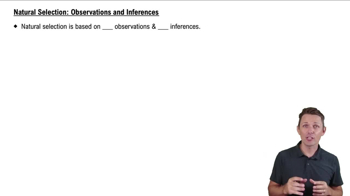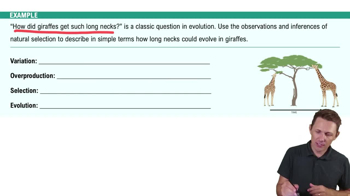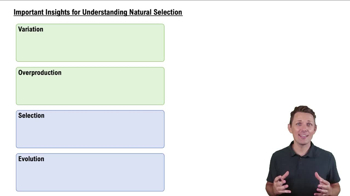Natural Selection exam Flashcards
 Back
BackNatural Selection exam
1/29
Terms in this set (29)
- Natural SelectionA key mechanism of evolution where certain traits enhance survival and reproduction, leading to evolutionary changes in populations over time.
- Observation 1 of Natural SelectionVariation is inherited; not all organisms in a population are identical, and much of this variation is passed from parent to offspring.
- Observation 2 of Natural SelectionSpecies tend to overproduce offspring, more than the environment can support.
- Inference 1 from Natural Selection ObservationsCertain traits will make survival and reproduction more likely, while others will make them less likely.
- Inference 2 from Natural Selection ObservationsTraits that help organisms survive and reproduce will accumulate in the population, leading to evolution.
- Example of Natural SelectionSnowshoe hares with coat color variation; white hares are less camouflaged in areas with little snow, leading to higher predation rates.
- AdaptationA trait that increases an organism's fitness in a particular environment.
- FitnessThe likelihood that an organism is able to survive and reproduce.
- Relative FitnessFitness measured in comparison to other organisms in the population.
- Absolute FitnessThe total number of offspring an organism produces.
- Does natural selection introduce variation?No, natural selection selects from existing variation in the population.
- What is required for natural selection to occur?Existing variation within the population.
- How does the environment affect fitness?Fitness depends on the environment; traits that are advantageous in one environment may not be in another.
- Population EvolutionPopulations evolve over time as the frequency of advantageous traits increases.
- Do individuals evolve?No, individuals do not evolve; populations do.
- How does natural selection affect populations over time?It increases the number of adaptations to the current environment.
- What happens if the environment changes?The population will evolve as different traits become advantageous.
- OverproductionThe production of more offspring than the environment can support.
- VariationDifferences in traits among individuals in a population.
- CamouflageAn adaptation that allows organisms to blend in with their surroundings.
- Example of OverproductionFemale snowshoe hares can birth 12+ offspring per year, but not all survive.
- What is the role of competition in natural selection?Members of the same species compete for resources, affecting which traits are passed on.
- Probability in Natural SelectionSurvival and reproduction are based on probability; advantageous traits increase the likelihood of survival.
- How does natural selection shape populations?It increases the frequency of advantageous traits, making populations better fit their habitats.
- Darwin's 4 PostulatesVariation, inheritance, overproduction, and differential survival and reproduction.
- Genetic VariationDifferences in DNA among individuals, leading to variation in traits.
- What is an example of a trait affected by natural selection?Coat color in snowshoe hares, which affects their camouflage and survival rates.
- How does natural selection lead to evolution?By increasing the frequency of traits that enhance survival and reproduction in a population.
- What is the ultimate result of natural selection?Populations become better adapted to their environments over time.


